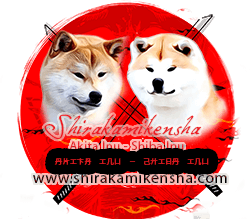Overview
This striking working breed originated from the province of Akita in Japan and dates to the 1600s when, legend says, it was bred to hunt the Yezo bear which overran a small island there. Later given to the Emperor, the breed became a symbol of good luck throughout Japanese culture. This strong and dedicated breed not only protected their royalty, but also was used to hunt large game such as deer and wild boar and bear. Today, it is still considered a symbol of good luck in Japan to own an Akita. These dogs make popular companion dogs and are known for being alert, loyal and fearless, making them excellent watchdogs.
Temparament
The Akita is an ACA recognized dog breed that will be extremely loyal and affectionate to his owner and family. Although the breed will be well-behaved inappropriate social encounters when introduced, these dogs can be very protective guardians of children and puppies. It is important to watch them around strangers, especially young children. They are generally quiet dogs and use barking to alert you. They are good watchdogs because of this and their protective nature.This intelligent breed should be socialized early with people, especially little children, other dogs, and pets. If you decide to adopt an Akita into your family, you will need to start socialization as early as possible and continue to socialize your puppy into adulthood. This will help him have a more favorable temperament when encountering unusual situations. Repetition is key in training him not to be aggressive. Keep in mind that if dogs, in general, are not properly socialized, they will often become anxious, depressed, or aggressive. When they are puppies, socialize them with other canines, other pets (especially smaller ones), new environments, and new people. Then, they will know they are safe around others, even when you are not there.
Adaptability
Although they can be aloof, they like spending time around their people. They are a loyal and loving breed, intelligent and independent. It is important to begin training early with your Akita to develop a mutual respect between your puppy and you. This training should continue right into adulthood, taking advantage of various situations to reinforce what you have already taught and praising their cooperation! They can easily get bored, so variety is the best choice for training and physical activities. Start training your puppy at home until he is up to date on vaccines including rabies shots, then puppy training classes will be most beneficial – unless you have had experience with the breed.
Health
As with any breed, there are some common health issues you might encounter. The Akita is generally healthy but can be prone to hip dysplasia, acquired myasthenia gravis, thyroid issues, progressive retinal atrophy, and some immune system disorders that can affect the hair and skin. Careful breeders screen their breeding dogs for genetic issues, but even with the best of breeding practices, it is possible for a genetic issue to arise.
Researching the Akita breed will help you be aware of potential conditions and should ease your mind regarding these issues. One of the best ways to keep your Akita healthy is to control his weight. It is one of the easiest ways to extend the life of this dog breed.
To keep your pet healthy, we suggest regular vet checkups, a nourishing diet, and an exercise routine. Discuss ailments or possible future ailments with your vet. By deciding on a specific diet plan, you and your veterinarian will help your dog enjoy good health for years to come. Like humans, as your dog matures we also suggest beginning physical therapy and possible brainteasers. This will keep the mind and body sharp as your dog ages.
Owner Experience
Due to its independent nature, a novice dog owner may find it difficult to handle an Akita without some training as well. With the help of a professional dog trainer, the transition will be a smooth one for both you and your new puppy.
Each dog breed is unique in personality and needs. Make sure you understand and research this breed before purchasing your Akita puppy from one of our reputable Akita breeders. Don’t be afraid to contact a prospective breeder and ask any questions you may have. You will be pleasantly surprised by how excited breeders are to discuss their puppies and practices. Plus, you may even walk away with some training tips!
Grooming
Akitas come in many colors including white, brindle and pinto. They can have a mask or not. They can have brown, black, tan or something in between as a second color.
The Akita has a very soft and dense undercoat; however, the outer coat is straight and coarse. This breed requires weekly brushing to help keep it clean and remove dead hair. It will lose its coat twice a year, in the spring and fall. This is when daily brushing is particularly important to help remove the outer coat and undercoat. As with any breed, it is important to keep nails trimmed and to begin a routine of at a young age.
Activity Level
The Akita requires less physical activity than most other breeds its size. These puppies need daily exercise, and a few brisk walks (or about 30 minutes of exercise) a day will keep them happy. They should be given the chance to run a few times a week to help with weight control.
Size
Akitas are 24 to 28 inches in height and 75 to 130 pounds in weight.

Life Span
An Akita generally lives 10 to 15 years.
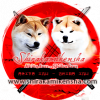



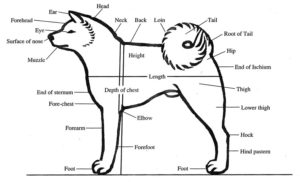 Large-sized dog, sturdily built, well balanced and with much substance ; secondary sex characteristics strongly marked, with high nobility and dignity in modesty ; constitution tough.
IMPORTANT PROPORTIONS : The ratio of height at withers to length of body ( from the point of the shoulders to the point of the buttock) is 10 : 11, but the body is slightly longer in bitches than in dogs.
BEHAVIOUR AND TEMPERAMENT :
The temperament is composed, faithful, docile and receptive.
Large-sized dog, sturdily built, well balanced and with much substance ; secondary sex characteristics strongly marked, with high nobility and dignity in modesty ; constitution tough.
IMPORTANT PROPORTIONS : The ratio of height at withers to length of body ( from the point of the shoulders to the point of the buttock) is 10 : 11, but the body is slightly longer in bitches than in dogs.
BEHAVIOUR AND TEMPERAMENT :
The temperament is composed, faithful, docile and receptive.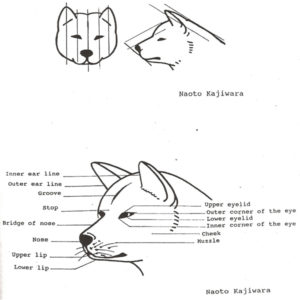
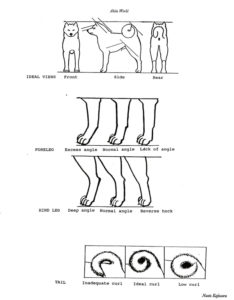 TAIL :
Set on high, thick, carried vigorously curled over back ; the tip nearly reaching hocks when let down.
LIMBS FOREQUARTERS :
TAIL :
Set on high, thick, carried vigorously curled over back ; the tip nearly reaching hocks when let down.
LIMBS FOREQUARTERS :
